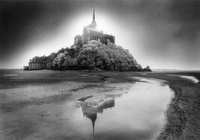Ghosthunter - A Journey through Haunted France
NORMANDY — MONT-SAINT-MICHEL
The Tomb on the Hill
22 September
At the mouth of the River Couescon, the traditional border between Brittany and Normandy since Roman times, lies one of the wonders of the western world.
On what was once a rocky island called Mont Tombe (The Tomb on the Hill), stands a huge Gothic monastery. In the fifteenth century, massive fortified walls were added to protect the abbey from the English, and over the centuries this great spiritual centre has been a place of pilgrimage for thousands of people. They would cross the bay on foot, risking the dangerous tides by routes known as ‘paths to paradise’, hoping for the assurance of eternity given by its founder Saint Michael, the Archangel of Judgement.
There are many legends and ghost stories concerning the mount. The most famous apparition is that of Louis d’Estouville, the commander of the garrison in 1434, who successfully defended the abbey from a powerful English army. It is said that the blood of two thousand Englishmen reddened the sands and that his phantom will haunt Mont-Saint-Michel for eternity.
I walked around the great walls in the early evening, with the abbey towering above me, and then further out into the sands, avoiding the pools left by the outgoing tide. All was eerily quiet; the only sound was the cries of the seagulls as they circled above. Looking at the mysterious Gothic building in its sensational setting, it was easy to understand why it so fascinated the great French writer Guy de Maupassant (1850—1893). I was reminded of the powerful description of it in his short story, ‘The Legend of MontSaint-Michel’: ‘The rocky castle, rising out there in the distance like a weird, seignorial residence, like a dream palace, strange and beautiful—this alone remained black in the crlmson light of the dying day.’
As a young man Maupassant had contracted syphilis, and through the disease he developed a mental disorder that becomes ever more evident in his nightmarish stories such as ‘The Apparition, Who Knows?’ and—most frightening of all — ’The Horla’ (1887), a tale of vampires, madness and suicide, in which the narrator visits Mont-Saint-Michel.



